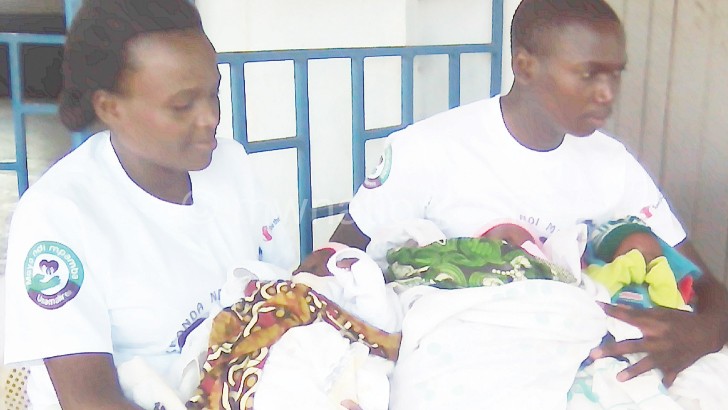Kangaroo care: Mother’s magic touch
It was her second pregnancy, and when she started experiencing labour pains, Sara Matabwa 23, started off for Thyolo District Hospital. She lives at Namaona Primary School, where her 25-year-old husband Emmanuel is a teacher.
That was on August 19. Seeing that nothing was happening five days later, a doctor at Thyolo District Hospital recommended that she goes for an X-ray. The results revealed that Matabwa is expecting triplets. Matabwa was shattered.
“When the doctor told me the news, I cried. The thought of delivering three babies scared me,” she says.
Her husband, on the other hand, was worried about how they would look after the three children in addition to their first born daughter who is currently in Standard One.

“I could not believe it when my wife told me the news. It was as if the world was against us,” he says.
On August 25, Sara finally delivered the triplets-two girls and a boy. They were named Catherine, Comfort and Cuthbert.
There was one problem though; the three babies were born with low weight.
“Catherine weighed two kilogrammes (kgs) while Comfort and the Cuthbert weighed 1.6 kgs each. I was told a baby has to be born with at least 2.5 kgs, and my worry was on their survival.
“But nurses said we would use Kangaroo Mother Care (KMC) to save them. I had no idea what it was, but they explained it and I understood,” says Matabwa.
KMC involves three key principles-warmth by positioning the baby skin-to-skin with the mother, increased breastfeeding and empowering the mother to care for her small baby, thereby allowing early discharge from the hospital.
Sara was discharged four days after delivery and was advised to follow KMC guidelines at home.
“My mother helped me with one child, so I would put on my chest the two with the lowest weight, and after some time, change to Catherine. She [her mother] would help me until my husband returned from work around 12 noon,” Matabwa explains.
Her husband said he ensured that he did all lesson plans at work so as to focus on the babies at home.
Two weeks later, Matabwa says Catherine and Comfort gained considerable weight, unlike Cuthbert.
“Catherine weighed 2.3 kgs from 2 kgs, Comfort moved to 1.7 kgs from 1.6 kgs but Cuthbert moved to just 1.63 kgs from 1.6 kgs.
“After four weeks. Catherine moved to 2.7 kgs, Comfort to 2.49 kgs, but Cuthbert moved to 1.7 kgs from 1.63 kgs,” she says.
Thereafter, the young mother says they intensified KMC for Cuthbert, and it paid off as during the sixth week, he weighed 2.6 kgs, while Catherine and Comfort moved to 3 kgs and 2.7 kgs respectively.
“My only worry now is how I will be buying necessities like formula milk because my wife cannot manage to breastfeed all three babies at once. We also need various food stuffs so that she remains strong,” says Matabwa’s husband.
Thyolo district health officer (DHO) Dr Michael Murowa says an average of 2 500 babies are born in the district every month, with 19 percent of them born with low birth weight, higher than the national average of 18 percent.
“At the district hospital alone, an average of 450 babies are born each month and about 40 of these are born with low birth weight. This is basically due to teenage pregnancies, infections like malaria, poor diet and HIV. The HIV prevalence rate here is high, at about 16 percent,” he says.
Murowa says KMC presents an opportunity to save newborns.
“For premature babies, kangarooing lowers oxygen requirements, stabilises heart rates and gives them an overall sense of peace. It is a magical touch,” he says.
With support from Save the Children, government recently launched a pilot health promotion campaign in Thyolo to increase the value of newborn life and community engagement in saving newborn lives.
The six-month long campaign, dubbed Khanda ndi Mphatso (a baby is a gift), focuses on promotion of KMC for low birth weight babies and pre-term babies.
Ministry of Health spokesperson Adrian Chikumbe says the campaign calls to action parents to give babies a chance to survive and thrive.
Says Chikumbe: “It is designed to bring together community and religious leaders, health care providers, policy makers and community members to jointly take actions that will result in the improvement of newborn health in the communities.”
Malawi’s neonatal mortality rate is estimated at 29 per 1 000 births and contributes almost 37 percent of all under-five deaths.
In September this year, Malawi committed to ending preventable child and maternal deaths by adopting the Sustainable Development Goals (SGDs). n






Low birth weight babies can cheaply be ensured of their survival through KMC. A costless way to care for Low birth weight babies